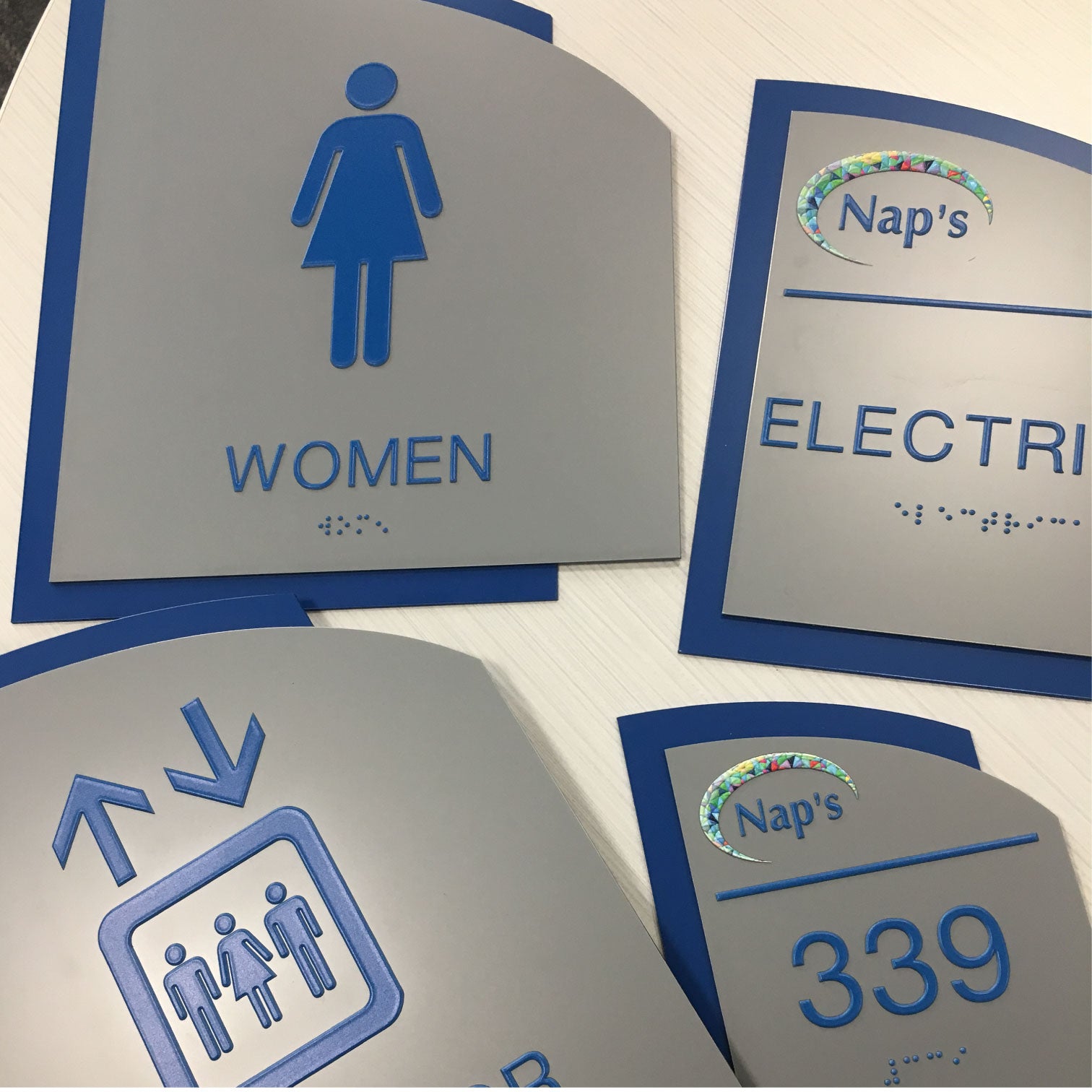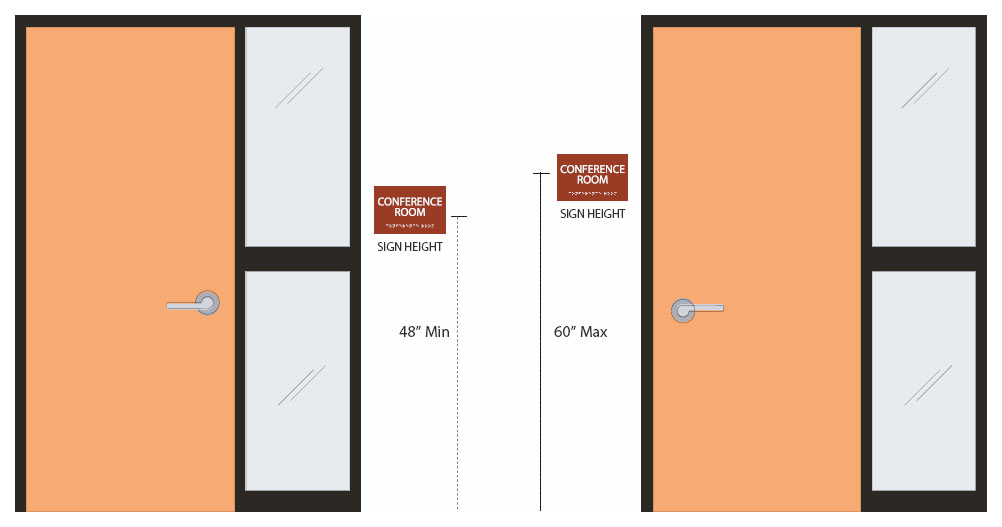Comprehending the Laws Behind ADA Signs
Wiki Article
Discovering the Trick Features of ADA Signs for Improved Availability
In the realm of access, ADA signs offer as quiet yet powerful allies, ensuring that areas are navigable and inclusive for people with disabilities. By integrating Braille and responsive elements, these signs damage barriers for the visually damaged, while high-contrast shade plans and legible font styles provide to diverse visual demands.Value of ADA Compliance
Guaranteeing conformity with the Americans with Disabilities Act (ADA) is essential for fostering inclusivity and equivalent access in public spaces and work environments. The ADA, established in 1990, mandates that all public centers, employers, and transport solutions suit individuals with disabilities, guaranteeing they appreciate the very same rights and chances as others. Conformity with ADA requirements not only satisfies lawful commitments however also improves a company's online reputation by demonstrating its dedication to variety and inclusivity.Among the key facets of ADA compliance is the execution of available signage. ADA signs are developed to guarantee that people with impairments can quickly navigate through buildings and rooms. These indicators have to follow particular standards relating to size, font, color contrast, and positioning to assure exposure and readability for all. Appropriately carried out ADA signage assists eliminate obstacles that individuals with specials needs commonly encounter, therefore advertising their self-reliance and confidence (ADA Signs).
Moreover, adhering to ADA regulations can minimize the danger of lawful consequences and potential penalties. Organizations that fall short to conform with ADA standards may face fines or claims, which can be both financially difficult and damaging to their public picture. Hence, ADA conformity is important to fostering a fair environment for everybody.
Braille and Tactile Components
The incorporation of Braille and tactile aspects right into ADA signs personifies the principles of accessibility and inclusivity. It is normally placed underneath the corresponding text on signage to guarantee that people can access the info without aesthetic aid.Responsive elements prolong beyond Braille and include raised characters and icons. These components are designed to be noticeable by touch, permitting individuals to determine space numbers, washrooms, exits, and other important locations. The ADA establishes certain guidelines regarding the dimension, spacing, and placement of these tactile components to maximize readability and make sure consistency across various settings.

High-Contrast Shade Systems
High-contrast color design play a crucial function in enhancing the presence and readability of ADA signs for individuals with aesthetic disabilities. These systems are vital as they maximize the difference in light reflectance in between text and background, ensuring that signs are conveniently discernible, also from a distance. The Americans with Disabilities Act (ADA) mandates the usage of certain color contrasts to suit those with restricted vision, making it an essential facet of compliance.The effectiveness of high-contrast colors hinges on their ability to stick out in various illumination problems, including poorly lit environments and areas with glow. Usually, dark message on a light background or light message on a dark history is employed to accomplish optimal contrast. Black text on a yellow or white background visit the site supplies a raw aesthetic distinction that aids in quick acknowledgment and understanding.

Legible Fonts and Text Size
When thinking about the style of ADA signage, the option of clear font styles and suitable text dimension can not be overemphasized. The Americans with Disabilities Act (ADA) mandates that font you can try here styles have to be not italic and sans-serif, oblique, manuscript, extremely ornamental, or of unusual kind.The dimension of the message likewise plays a critical role in accessibility. According to ADA standards, the minimum message elevation need to be 5/8 inch, and it needs to why not look here boost proportionally with checking out range. This is particularly important in public areas where signage requirements to be read quickly and properly. Consistency in text size contributes to a natural visual experience, assisting people in navigating environments successfully.
In addition, spacing between letters and lines is important to legibility. Appropriate spacing prevents personalities from appearing crowded, improving readability. By sticking to these requirements, developers can significantly enhance availability, ensuring that signage offers its intended objective for all individuals, no matter their visual abilities.
Reliable Placement Strategies
Strategic positioning of ADA signs is vital for making the most of access and ensuring conformity with lawful standards. Appropriately located signs direct people with disabilities successfully, promoting navigating in public spaces. Key factors to consider include height, distance, and exposure. ADA guidelines specify that indicators must be installed at a height between 48 to 60 inches from the ground to ensure they are within the line of view for both standing and seated people. This basic height range is crucial for inclusivity, allowing mobility device customers and people of differing heights to gain access to info easily.Additionally, indicators must be put nearby to the lock side of doors to enable very easy identification prior to entrance. Consistency in indicator placement throughout a center enhances predictability, lowering complication and enhancing overall customer experience.

Conclusion
ADA signs play an important function in promoting ease of access by integrating attributes that address the needs of people with disabilities. These components jointly cultivate a comprehensive atmosphere, underscoring the value of ADA compliance in making sure equal gain access to for all.In the realm of ease of access, ADA signs offer as quiet yet powerful allies, making sure that areas are inclusive and accessible for individuals with disabilities. The ADA, enacted in 1990, mandates that all public centers, companies, and transportation services suit individuals with handicaps, guaranteeing they take pleasure in the exact same rights and possibilities as others. ADA Signs. ADA indications are developed to ensure that people with specials needs can easily browse with buildings and rooms. ADA guidelines specify that signs need to be installed at a height in between 48 to 60 inches from the ground to ensure they are within the line of sight for both standing and seated people.ADA signs play a crucial role in advertising availability by integrating functions that address the demands of individuals with specials needs
Report this wiki page